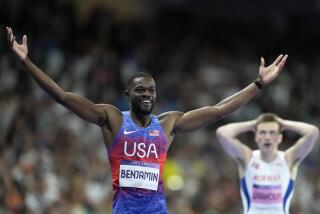Marathoner Does It Hard Way--With Heart, Hands
- Share via
“ . . . and the last shall be first.” --Matthew, 19:30.
Bob Wieland of Pasadena came in last in the New York City Marathon.
He didn’t cross the finish line until 11:15 a.m. Thursday, winding up in 19,413th place, 4 days, 2 hours and 17 minutes after he’d started.
But in coming in last, the 40-year-old Wieland wound up first in the hearts of New Yorkers. Because Wieland did it without legs.
He did it on his hands, swinging his torso forward about a yard at a time on his powerful arms, at an average speed of about 1 m.p.h. His hands were encased in thick leather gloves which he calls “size 1 running shoes,” his lower body protected by leather “chaps.”
“I knew I could handle the marathon,” Wieland said late Thursday in a telephone interview. “I knew because I had just completed my 2,784-mile walk across the country and I’m in good shape. . . . I’m a born-again Christian and this was a demonstration that faith in the Lord Jesus will always overcome the impossible.” Wieland lost both legs when, as an Army combat medic, he stepped on a land mine in Vietnam in 1969.
Until late Wednesday night, it was thought that the final finisher in the 26-mile, 385-yard race was free lance writer Aaron Shorr, one of 49 handicapped competitors sponsored by the Achilles Track Club. Shorr crossed the line at 11:26 p.m. Sunday.
“I thought he (Wieland) gave up,” race director Fred Lebow said.
But Wieland is not the kind who gives up.
When Lebow learned that the double-amputee was still on the course Wednesday night--just two miles from the Central Park finish line--he persuaded Wieland to take a hotel room for the night so he could cross the line with news cameras on hand to record his accomplishment.
The race director also was worried about Wieland’s condition. “I was totally exhausted,” Wieland said. “I did 10 1/2 miles the first day . . . and basically I just kept going, with a half-hour break now and then for a nap. . . . Yesterday (Wednesday) it was pouring down rain and the temperature had dropped into the 30s.” So, after a good night’s sleep, he finished the race, shouting “We love New York.”
The people of New York, he said, “were awesome” in the support and encouragement they gave him. “They kept yelling ‘God Bless you!’ and ‘Go for it!’ ”
Delayed by Spectators
Wieland’s necessarily slow pace was further hampered by spectators he encountered as he swung along on the sidewalks parallel to the race course. “People come up and talk to me and wish me well,” he told a reporter. He said he always stopped to talk because he didn’t want to be rude.
Wieland, who is a member of the President’s Council on Physical Fitness, said he entered the marathon to demonstrate to the youth of America that anyone can do anything if he tries hard enough.
In an earlier interview, Wieland said it was in 1969, while still recovering from his devastating wounds, that he decided he would break a world record one day. He began a demanding regimen of weightlifting and body building and within a year he’d won a gold medal in a bench-press competition in the National Wheelchair Olympics.
Then, in 1977, competing against athletes with no handicaps, he broke the world’s bantamweight bench-press record with a lift of 303 pounds. Later, however, contest officials decided he was not entitled to the title. “They refused to accept my lift as an official record,” he said “The rules say you have to wear shoes.”
Teaches, Coaches
Wieland later earned a degree in physical education at California State University, Los Angeles, and taught and coached at the school from 1975 until 1982.
On Sept. 8, 1982, he set out on a “Walk for Hunger” across the country to raise money for the needy. He finished the journey last May in an emotion-laden ceremony at the Vietnam Veterans Memorial in Washington. He had raised $315,000 for charities.
More to Read
Go beyond the scoreboard
Get the latest on L.A.'s teams in the daily Sports Report newsletter.
You may occasionally receive promotional content from the Los Angeles Times.










